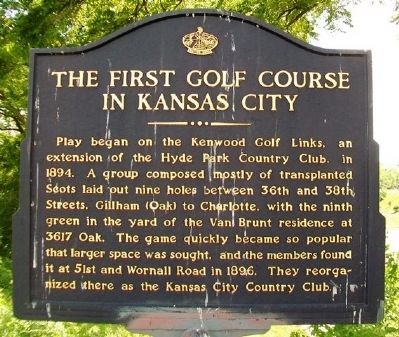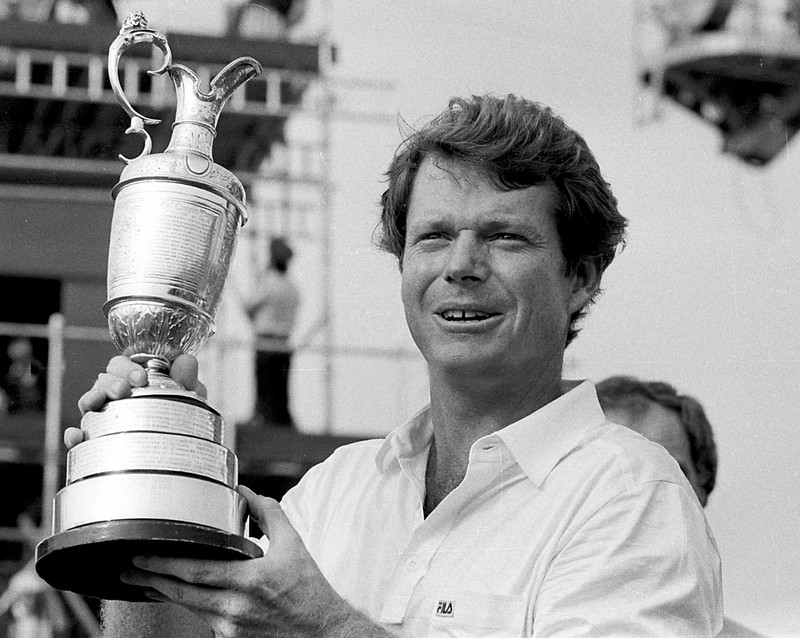The First Golf Course in Kansas City
Introduction
Text-to-speech Audio
Images
The First Golf Course in Kansas City marker

Kansas City Country Club's Most Famous Player, Tom Watson

Backstory and Context
Text-to-speech Audio
Brief History of Golf in Kansas City
According to various traditions, the first formal golf course in the United States was the St. Andrews Golf Course in Yonkers, New York. In addition to being one of the oldest (founded in 1888), the St. Andrews Course still runs to this day, making it the longest continual Club as well.
Some of the older courses include the Oakhurst Golf Course (1884) and the South Carolina Golf Club (1788, though there are no records of golf ever being played there. It mostly served as a social club), and west of the Mississippi, some sources say the Kenwood Course is the oldest. However, golf first came to the Kansas City area at about the same time as the St. Louis, St. Joseph, Omaha, and Iowa courses.1
The first layout for Kenwood was created by Frank Young and Dr. John Binnie in 1894. Some attribute the birth of golf in Kansas City to a young Scot named Stanley Young, who came to Kansas City in the 1890s. At the time, Young expected that a place like Kansas City, with a population of around 132,000, would at least have one golf course.
Aching to practice, Young kept on the lookout for some open space where he could tee off, and eventually he found that space between 34th and 36th streets. Men living on McGee, intrigued by Young’s strange-looking activities, most likely came down to watch. Young could see their interest and ordered them clubs from Boston.
Two years after the sport of golf started in Kansas City, it had become so popular that many golfers requested larger spaces to play. The Kansas City Country Club was thereafter incorporated in 1896 by several civic leaders, including the Civil War hero and local businessman, Charles Fessenden Morse.
For the new course, the earliest members of the country club leased a pasture at what today is Loose Park. According to an article published in the May 6th, 1986 edition of Westport’s Sentinal Examiner, the land included 120 acres on the west side of what is now Wornall Road and between 51st and 55th streets. The course’s clubhouse was built by acclaimed architect W.C. Root.2
Inscription on the Historical Marker
Play began on the Kenwood Golf Links, an extension of the Hyde Park Country Club, in 1894. A group composed mostly of transplanted Scots laid out nine holes between 36th and 38th Streets, Gillham (Oak) to Charlotte, with the ninth green in the yard of the Van Brunt residence at 3617 Oak. The game quickly became so popular that larger space was sought, and the members found it at 51st and Wornall Road in 1896. They reorganized there as the Kansas City Country Club.3
Cite This Entry
Newcomer, Daniel and Ben M.. "The First Golf Course in Kansas City." Clio: Your Guide to History. May 15, 2017. Accessed March 26, 2025. https://theclio.com/tour/2016/14
Sources
2.) Kennedy, Lyle. "The Hyde Park Golf & Country Club." Accessed July 4, 2015. http://history.hydeparkkc.org/index.php?option=com_content&view=article&id=181:the-hyde-park-golf-a-...
3.) "The First Golf Course in Kansas." The Historical Marker Database. Accessed July 4, 2015. http://www.hmdb.org/marker.asp?marker=67795.

